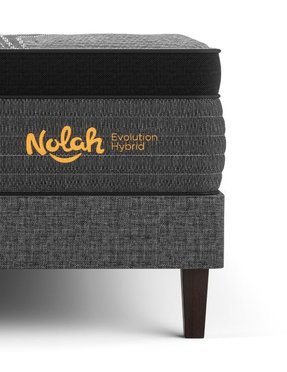Earth Day: 7 Ways to Sleep Green and Maintain an Eco-Friendly Bedroom
With spring emerging and Earth Day right around the corner, it’s the perfect time to stop and smell the fresh air, enjoy the outdoors, and appreciate the Earth around you.
As you spend time outside and enjoy the natural beauty, take Earth day as an opportunity to reflect on your own carbon footprint and lifestyle habits. Leading a more eco-conscious life may sound like a daunting task, but there are countless ways—big and small—to lessen your environmental impact. In fact, you can do it in your sleep.
To help you refresh your sleep environment and nighttime habits in an eco-positive way, we’ve put together a list of green bedroom products and energy-conserving practices you can try in honor of Earth Day.
1. Invest in a Natural Mattress
Unfortunately, your mattress may be the least eco-friendly aspect of your bedroom. To create a true sleep sanctuary, it may be time to donate your old bed and invest in a natural option you can feel good about.
When it comes to mattresses, you don’t have to sacrifice comfort for eco-consciousness. Latex—an all-natural and sustainable material—happens to make a responsive foam with exceptional pressure relief.
Natural latex mattresses, such as the Nolah Natural, have a unique “bouncy” feel. Like other foams, latex foam contours to your curves, cradling and cushioning your joints while you sleep. Plus, latex foam is chemical-free and naturally hypoallergenic, making it a great choice for sensitive sleepers with allergies or asthma. It’s also breathable and percent temperature neutral, so it sleeps comfortably cool.
Last but not least, natural latex is highly durable. With proper care, a latex mattress can last about 20 years. They cost more than other mattress types, but you’ll keep your bed longer, making it better for your wallet and the environment.
Eco-Friendly Mattress Shopping Tip
If latex isn’t for you, we recommend a polyfoam mattress with CertiPUR-US certification. While most synthetic mattress foams contain some level of volatile organic compounds (VOCs), you can seek out CertiPUR-US foams that are certified safe and free from ozone depleters, heavy metals, and chemical fire retardants.
Nolah’s foam mattresses—the Nolah Original, Signature, and hybrid Evolution—use CertiPUR-US foam. You can click here to learn more about our mattresses and their environmental certifications.
2. Turn Down the Heat Before You Sleep
Turning down the heat at night not only conserves energy—but it’s also the most natural way to sleep.
Your body operates on a 24-hour sleep-wake cycle, a circadian rhythm that dictates when you feel tired or awake. When bedtime approaches, the brain releases a hormone called melatonin, which makes you feel sleepy and cools the body down. This triggers a slight drop in core temperature, which you maintain through the night until the body prepares for wakeup.
However, if your environment is too hot and your body can’t cool itself down, it disrupts this natural process. You’re more likely to toss, turn, and have trouble drifting off to sleep. To avoid this disturbance and save on your electric bill, you should keep your bedroom around 65 degrees Fahrenheit throughout the night.
3. Opt For Natural, Temperature-Regulating Sheets and Bedding
Many bedding materials have a bad rep for chemical treatments. For example, synthetic materials like microfiber can release toxins like phthalates and formaldehyde.
Fortunately, there are plenty of all-natural materials that make soft and durable bedding. For example, organic cotton and linen all make excellent bed sheets, pillowcases, comforters, and other bed dressings.
4. Refresh Your Wardrobe With Sustainable Sleepwear
Speaking of eco-friendly fabrics—don’t just dress your bed with green materials; dress yourself with comfortable and eco-conscious sleepwear.
What fabrics should you avoid? Polyester and nylon are two of the least sustainable clothing materials.
Instead, we recommend pajamas made with lightweight and breathable natural materials. For example, silk and linen provide cooling comfort, plus they have a luxurious look. However, these premium materials tend to have high price tags. If you’re eco-conscious but on a budget, opt for organic cotton.
5. Embrace Natural Light
Considering you spend most of your time in your bedroom asleep, there’s no need for bright, over-the-top light fixtures. All you need is a couple of lamps powered by energy-efficient LED light bulbs.
Aside from that, we recommend leaning into natural lighting to brighten the mood. If you choose a light paint color, add some strategically-placed mirrors, and arrange your furniture around the windows, all you need is the Sun to see by during daylight hours.
6. Choose Insulating Curtains
Especially in older houses, heat (or air-conditioned cold air) unfortunately escapes through windows, even when they’re closed. You may not be able to replace the insulation, but you can protect your windows with insulating curtains.
Thermal curtains help maintain the temperature of the room, saving your heating or cooling system from extra work. Plus, they dampen noise, helping you sleep soundly through the night.
7. Decorate With Plants
Decorating with plants not only heightens your bedroom’s style but can also improve air quality, boost your mood, and even help you sleep. According to recent research from Beihang University, the color and soothing smell of certain plants can reduce stress, lowering cortisol levels and making it easier to fall asleep.
Dreaming of a Greener World
Hopefully, these tips have inspired you to make a few changes to your sleep habits and bedroom. They may not sound like planet-saving measures, but every little bit helps. Plus, living in a clean, toxin-free environment can help improve your personal health, so it’s a win-win all around!




You May Also Like These Articles
Don't Sleep on Exclusive Offers
Sign up for our newsletter, and you'll be the first to know about discounts, deals, and what's new at Nolah.
Ready for Bed?
